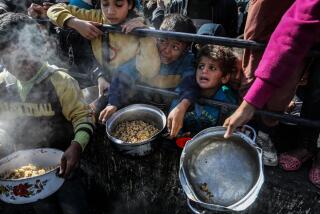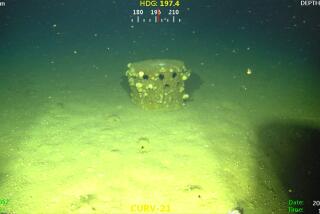Uncle Gassed in World War I : Australian’s Fight to Abolish Chemical Warfare Is Personal
- Share via
CANBERRA, Australia — In 1939, when Peter Dunn was only 10 years old, he sat at his Uncle Claude’s bedside in a Tasmanian hospital and watched him slowly die.
Claude Dunn had been among the thousands of Australian troops who had fought in the trenches of France during World War I and been gassed with phosgene, one of the then-new deadly chemical weapons unleashed by the Germans. More than two decades later, after he had been hospitalized dozens of times, the lethal chemical finally ate away at his lungs.
‘Left Terrible Impression’
“That experience left a terrible impression on me,” Peter Dunn recalled last week. “Ultimately, it dictated the course of my life.”
It would also have a major impact on Australia and the world at a crucial juncture half a century later. After his uncle’s death, Dunn, the son of a Tasmanian timber farmer, decided to become a chemist.
For more than three decades, the soft-spoken, self-effacing Dunn worked away quietly in Australian laboratories, researching and developing defenses against poison and nerve gases--even though they appeared to have been made obsolete by a 1925 accord passed in response to the more than 1 million World War I deaths from chemical weapons.
Dunn never expected to see a battlefield, much less be confronted with live chemical weapons. But, in 1984, he was hastily summoned from vacation in the Melbourne countryside. The mission, he was told, was so secret that he could not even tell his family.
Dunn ended up in Iran.
He also ended up being exposed to weapons far more deadly than those that killed his uncle.
Because of his long years of work on chemical weapons, Dunn was appointed to a four-man U.N. team dispatched to the Gulf War front to verify Iran’s claims that Iraq was firing artillery shells and dropping bombs filled with poisons.
Within 48 hours of his arrival, Dunn was facing a 250-kilogram bomb filled with lethal poison gas dropped by Iraq on Iranian positions on Majnun Island. The bomb had fallen into the swamp and failed to go off. But it was still live.
“There was no time to read the instruction manual. These were not normal circumstances. The revolutionary guards were waving guns and shouting (for us) to do something. We had to do whatever we could on the spot,” he said.
So, surrounded by hundreds of Iranian soldiers, Dunn and a Swiss munitions expert donned yellow Playtex gloves and gas masks and “delicately, very delicately” defused the bomb.
They then gently extracted the sticky substance which, Dunn said, he immediately knew was mustard gas.
Dunn recalled that he did not feel fear at that moment. “I was so overwhelmed by the magnitude of what I had found. I knew this was so important on the world scene. This would be the most thorough documentation of a chemical weapons violation since World War I.”
What did make him nervous, however, was the reaction of the revolutionary guards. After Dunn extracted his samples, the excited Iranian troops tipped the bomb on its side and started pouring the gas--without precautions--into empty Coke bottles to keep as samples.
“This,” said Dunn in a kind of understatement that typifies his speech, “was dangerous.”
Even a drop of the liquid or a whiff of the vapor can be lethal.
Later Horrified
He was later horrified to learn that the Iranians had transported more than a dozen similar bombs, also still alive, on aircraft back to Tehran.
“This was not the safest thing to do,” he noted.
But that was only the beginning. Dunn also visited morgues, where coffins were opened for him to see victims, each wrapped in plastic, who had already died from asphyxiation. Mustard gas, like phosgene, destroys the lungs. The plastic was to protect anyone who might touch a body.
But his biggest discovery was in the simple brown paper bag.
On a second trip to the Gulf War’s front lines, Dunn and his U. N. colleagues were taken to a hospital in the Iranian border town of Ahvaz. Just looking at the 40 victims, Dunn knew that these cases were different.
Many of these people were effectively blind because their pupils had contracted to pinpoints. Many of them were also trembling in spasms. They had lost control of their muscles.
“Most of them were also salivating from the mouth and nose. It was as if they had been struck by a hidden virus.”
Ten of the 40 soon died.
With pride, the Iranians told Dunn that they had collected samples of the substance that had caused the injuries. They were keeping them in two small pill containers buried in sand in a grocery bag at the hospital’s lab.
“This was not something we could walk away from,” Dunn said. He and Swedish Dr. Gustav Andersson immediately asked for gas masks and syringes. They then ordered everyone else out of the room.
The two men laid out a plastic sheet on the floor, sifted through the sand for the tiny containers and then, “carefully, very carefully,” used the syringes to extract the brown murky liquid.
‘Nerve Gas’
“We could tell by sight it was nerve gas. It was the most moving experience of my life,” Dunn recalled. “This was a class of weapons never used before in battle.”
Two classes of nerve gas--Tabun and Sarin--were developed by the Germans in the 1930s. But they were never used in World War II.
“Historically and scientifically, our work in a small Iranian hospital was a momentous event,” Dunn said. “It was the most useful thing I have ever done.”
Labs in Switzerland and Sweden later verified that the substance was Tabun, a potent nerve gas that can kill in seconds after only minimal exposure. Where death is prolonged, it is agonizing because of the gradual deterioration of the nervous system.
The evidence collected for the United Nations in Iran mobilized world public opinion and injected new urgency in the disarmament conference on chemical weapons that by then had dragged on in Geneva for 13 years. Shortly after the release of the U.N. report, then Vice President George Bush flew to Geneva with broad new proposals that now form the framework for a treaty.
And Monday, declaring the world “has lived too long in the shadow of chemical warfare,” President Bush revealed the details of a U.S. proposal aimed at spurring the 40-nation conference in Geneva to ban chemical weapons entirely within 10 years. In his first speech to the United Nations General Assembly as President, Bush offered, initially, to slash U.S. stocks of such weapons more than 80% provided the Soviet Union reduces to an equal level. “These horrible weapons,” he said, “are now finding their way into regional conflicts,” a situation which Bush called “unacceptable.”
Dunn may take some comfort that his fact-finding trips undoubtedly played a part in development of the U.S. proposals.
Pleads to Act
In fact, his 19-day trip to Iran so upset him that, upon his arrival back in Canberra, he immediately met with Australia’s then-foreign minister Bill Hayden and other leading officials to plead with them to act.
Because Australia suffered more casualties, proportionately, from chemical warfare than any other nation during World War I, Canberra has long been outspoken in urging a worldwide ban. But Dunn urged it to go one step further.
The result was the Australia Group, an organization of 19 nations with advanced chemical industries, including the United States, that since 1985 has met every six months at the Australian Embassy in Paris.
Dunn’s work in mobilizing Australia to take a lead on a new treaty was evidenced last week at an international conference, the largest ever held in Australia, which for the first time brought together the world’s chemical manufacturers and more than 70 governments.
Dunn’s fact-finding activities did not end in 1984. After further accusations of chemical weapons use in the Gulf War, he made two more trips to Iran and one to Iraq in 1986 and 1987.
“Everyone told me I was mad to go back. But I had incredible drive to collect the evidence,” he said. “I had to do this.”
Each time he went back, Dunn was even more appalled. On one of seven trips to the front, he discovered that Iraq had equipped a multiple rocket launcher, capable of firing 40 rounds in a single salvo, with chemical warheads.
The casualties on another visit were so numerous that a Tehran sports stadium was converted into a makeshift hospital with 2,000 beds.
And on his last trip, he watched a 4-year-old girl die from mustard gas burns. Her 2-year-old sister survived, but will be grossly disfigured for life.
On each trip, Dunn snapped away with his camera, in between inspecting weapons, taking samples and visiting victims. He now has more than 300 pictures assembled in three thick scrapbooks and three diaries full of his findings.
“I wanted to make sure that we had complete documentation, that no one would ever dispute our findings,” he said. “Now no one can deny what we found.”
Nonetheless, Iraq, which sent a delegation to this week’s conference in Canberra, continues officially to deny that it has chemical weapons.
On the 50th anniversary of his uncle’s death, Dunn, now 60, has become one of the world’s foremost specialists on chemical warfare. For his efforts, he was awarded the 1989 Anzac Peace Prize, Australia’s domestic equivalent of the Nobel, for his contribution to world peace.
Is he optimistic that a treaty, now in its 19th year of negotiation, is imminent?
“It has to be,” he said. “No nation can afford to allow chemical weapons to become legitimized for use in modern warfare.
More to Read
Sign up for Essential California
The most important California stories and recommendations in your inbox every morning.
You may occasionally receive promotional content from the Los Angeles Times.










